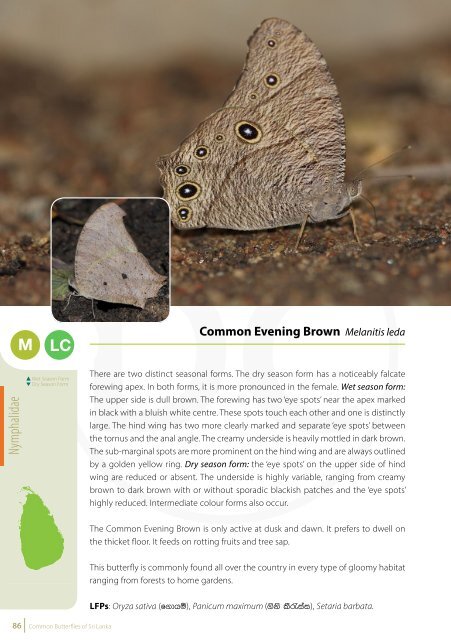Common Butterflies of Sri Lanka
Common Butterflies of Sri Lanka
Common Butterflies of Sri Lanka
You also want an ePaper? Increase the reach of your titles
YUMPU automatically turns print PDFs into web optimized ePapers that Google loves.
M<br />
LC<br />
<strong>Common</strong> Evening Brown Melanitis leda<br />
Tamil Tree Brown Lethe drypetis<br />
S<br />
EN<br />
Nymphalidae<br />
Wet Season Form<br />
Dry Season Form<br />
There are two distinct seasonal forms. The dry season form has a noticeably falcate<br />
forewing apex. In both forms, it is more pronounced in the female. Wet season form:<br />
The upper side is dull brown. The forewing has two ‘eye spots’ near the apex marked<br />
in black with a bluish white centre. These spots touch each other and one is distinctly<br />
large. The hind wing has two more clearly marked and separate ‘eye spots’ between<br />
the tornus and the anal angle. The creamy underside is heavily mottled in dark brown.<br />
The sub-marginal spots are more prominent on the hind wing and are always outlined<br />
by a golden yellow ring. Dry season form: the ‘eye spots’ on the upper side <strong>of</strong> hind<br />
wing are reduced or absent. The underside is highly variable, ranging from creamy<br />
brown to dark brown with or without sporadic blackish patches and the ‘eye spots’<br />
highly reduced. Intermediate colour forms also occur.<br />
The <strong>Common</strong> Evening Brown is only active at dusk and dawn. It prefers to dwell on<br />
the thicket floor. It feeds on rotting fruits and tree sap.<br />
This butterfly is commonly found all over the country in every type <strong>of</strong> gloomy habitat<br />
ranging from forests to home gardens.<br />
The outer margin <strong>of</strong> the hind wing is serrated making a short tail at the tornus. Male:<br />
Dark brown on the upper side with a few small, black sub-marginal spots on the<br />
hind wing. The underside is dark brown, clouded with a purplish tinge. The spots on<br />
interspaces 2 and 6 on the hind wing are equally large and rounded. The other ‘eye<br />
spots’ are not rounded and have minute white spots throughout the black centre. The<br />
‘eye spots’ on the forewing lack the golden brown rings. Female: A large portion <strong>of</strong> the<br />
distal parts <strong>of</strong> the forewing is darker than the basal area on the upper surface, and has<br />
two dull, white oblique bands. The black spots on its hind wing are more pronounced.<br />
The underside is similar to that <strong>of</strong> the male except for the reduced intensity <strong>of</strong> the<br />
purple scales, and the broad, irregular, oblique band across the forewing.<br />
The Tamil Tree Brown depends on rotting fruits and tree sap. It occasionally opens its<br />
wings to bask on cool days.<br />
This forest-dwelling species is found under the shade <strong>of</strong> thickets, especially around<br />
bamboo plants. It is a hill country butterfly, but declines in numbers at the highest<br />
levels <strong>of</strong> elevation giving space to the <strong>Sri</strong> <strong>Lanka</strong>n Tree Brown.<br />
Female<br />
Male<br />
Nymphalidae<br />
LFPs: Oryza sativa (f.dhï), Panicum maximum (.sks lS/iai), Setaria barbata.<br />
LFPs: Davidsea attenuata, Bambusa vulgaris (WK), Dendrocalamus giganteus<br />
86 <strong>Common</strong> <strong>Butterflies</strong> <strong>of</strong> <strong>Sri</strong> <strong>Lanka</strong><br />
<strong>Common</strong> <strong>Butterflies</strong> <strong>of</strong> <strong>Sri</strong> <strong>Lanka</strong> 87















